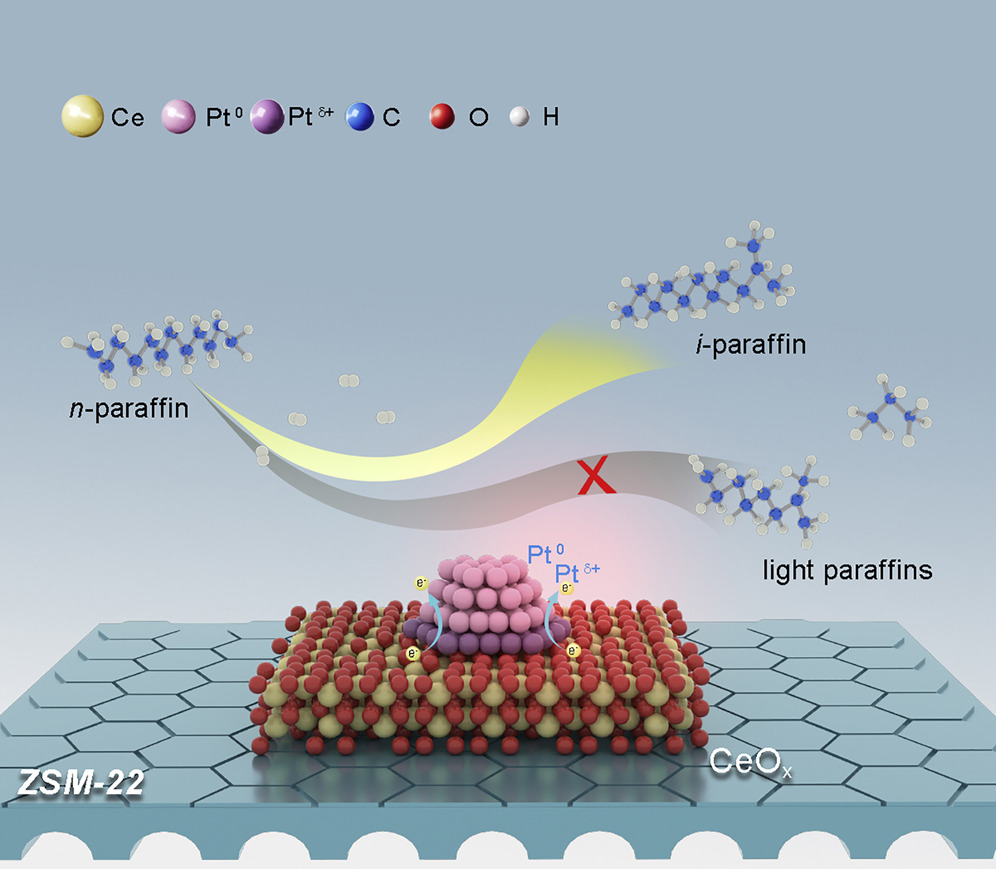One of the most significant reactions in the chemical industry is n-paraffin hydroisomerization, which is catalyzed by bifunctional catalysts.
 The electron transfer pathway and n-paraffin conversion scheme on the PtCeOX/ZSM-22 catalyst. Image Credit: Congxin Wang
The electron transfer pathway and n-paraffin conversion scheme on the PtCeOX/ZSM-22 catalyst. Image Credit: Congxin Wang
An acid and a noble metal function are present in the bifunctional catalyst utilized in this process. The key to good catalytic performance is the harmony of these two processes. If there is an imbalance, the isomerized carbonium ions that develop on the acid sites will break and produce light alkanes.
Recently, a research team from the Dalian Institute of Chemical Physics (DICP) of the Chinese Academy of Sciences (CAS) under the direction of Professors Zhijian Tian and Congxin Wang created a new method to improve the intrinsic property of metal function and created a highly effective PtCeO×/ZSM-22 catalyst for the n-paraffin hydroisomerization reaction.
On January 26th, 2023, the study was published in Chem Catalysis.
To create CeO× species across the rod-like ZSM-22 support and fix Pt nanoclusters on the surface of ceria, the researchers suggested a simple sequential impregnation procedure that took advantage of the difference in point of zero charges between the ZSM-22 support and ceria additive.
Between Pt and CeO×, they discovered an electron transfer. The catalyst’s intrinsic activity was significantly increased as a result of this electron transfer effect.
In the first dehydrogenation of the alkanes phase, it allowed Ptδ+ species to swiftly activate C-H bonds, and in the final hydrogenation step of the n-paraffin hydroisomerization process, it allowed Ptδ+ species to contribute the electron to saturate the branched alkenes.
This catalyst (0.3wt%PtCeO×/ZSM-22) outperformed every previously reported commercial Pt/ZSM-22 catalyst with traditional high Pt content (no less than 0.5wt% Pt) in terms of n-paraffin hydroisomerization with enhanced turnover frequency, high isomer selectivity (96%) at high n-paraffin conversion rate (91%), and an 87% i-paraffin yield.
This work provides not only new insights into Pt-metal oxide interaction in bifunctional catalysts, but also strategy for efficient bifunctional catalyst manufacture in potential industrial applications.
Congxin Wang, Professor, Dalian Institute of Chemical Physics, Chinese Academy of Sciences
Journal Reference:
Peng, Y., et al. (2023) Boosting catalytic performance via electron transfer effect for hydroisomerization on a low-Pt-content PtCeOX/zeolite catalyst. Chem Catalysis. doi:10.1016/j.checat.2023.100505.